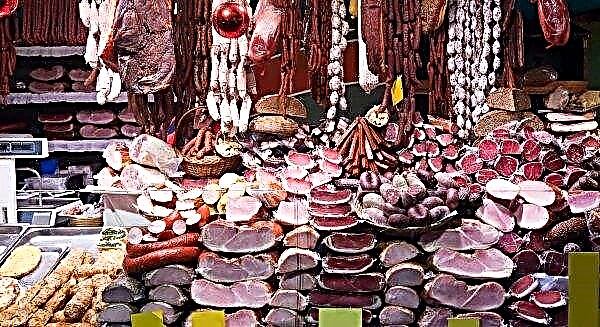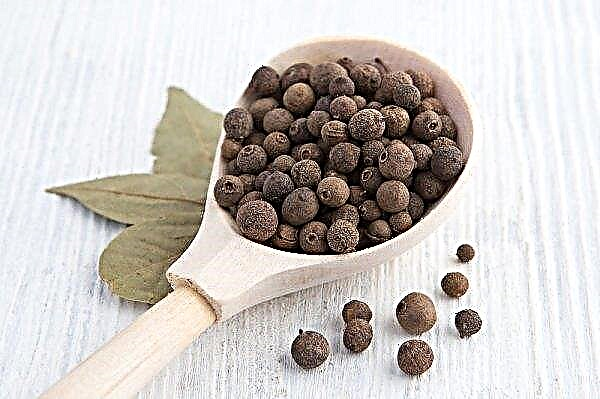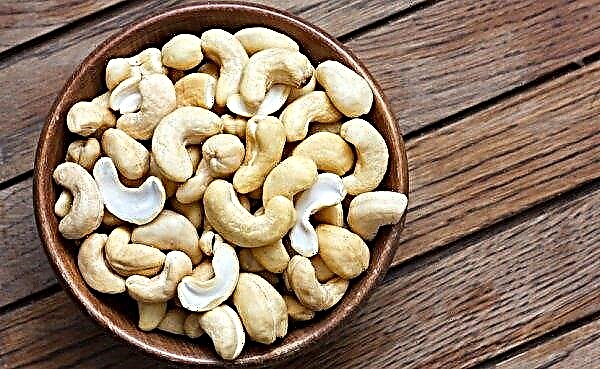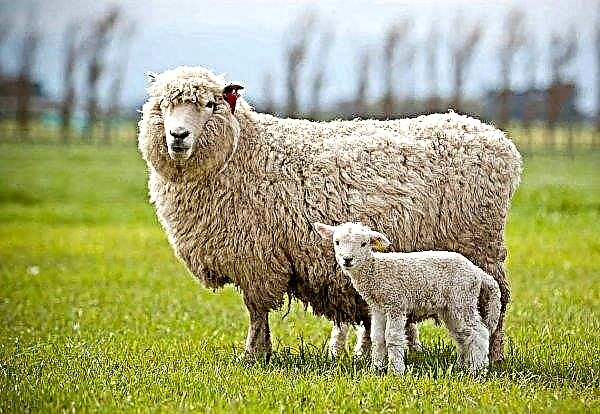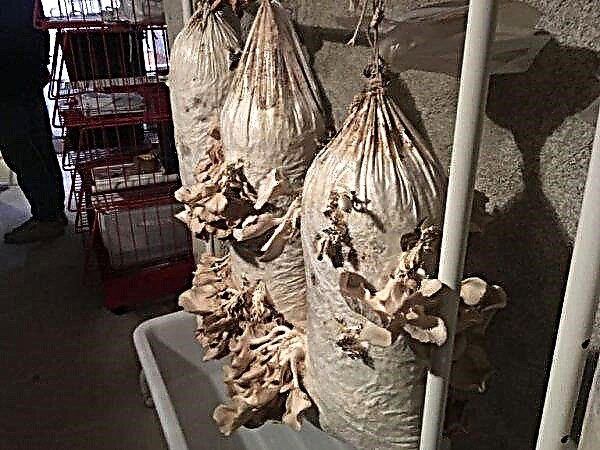Royal oyster mushroom, eryngi, single barrel, steppe or steppe porcini mushroom - these are the names used in different countries of the world to denote the usual oyster mushroom. Let us consider in more detail its description, what useful properties a common mushroom has, how to cook oyster mushroom at home and prepare it for the winter.
Description oyster mushrooms steppe
Yeringi, like any other mushroom, has the characteristic features of appearance and taste, which allows it to occupy a leading position among the preferences for picking from mushroom pickers.
Hat
The diameter of the cap of the steppe oyster mushroom is very different in different periods of growth. Young specimens have a hat 4.5 cm, fully mature - about 13 cm. At the beginning of growth, a small tubercle is located in the center of the hat, which eventually turns into a depressed spot. The color of the surface of the cap is red-brown (in the young mushroom) and brownish, pale ocher with white edges in the adult specimen. The structure of the cap skin is fibrous or finely scaly, smooth to the touch.
Gimenofor
The hymenophore is highly developed, which allows to produce the maximum number of spores, and therefore the one-barrel grows in large families. The plates located under the hat partially pass to the leg. Planted densely. The color of the plates is creamy pink and has a uniformly painted solid edge. Spores are beige, narrowly elliptical or cylindrical.
Pulp
Steppe oyster mushroom is meaty due to the large size and volume of tissue. The pulp is dense in young mushrooms, in overripe ones it is more friable, has a white or light yellow color, sometimes with a brown or pink hue. Oyster mushroom does not have a pronounced mushroom smell. The taste of pulp is pleasant, mushroom.
Did you know? In the world there is a mushroom that does not have legs and can move around, shifting from one side to another. It is called "Plasmodium» and looks very much like a shrunken jellyfish - translucent and gelatinous.
Leg
The height of the legs of the steppe mushroom is from 2 to 5 cm in height, and usually does not exceed 2.5 cm in diameter. Has a central or eccentric location. The shape of the legs is cylindrical, thickened at the base. The color of the legs of the young specimen is white, with time it becomes brownish-buffy. Old mushrooms often have a "cotton", cobwebby flesh.
Where does steppe porcini mushroom grow
Royal oyster mushroom is quite common in the wild in many countries. The natural habitat is represented by Central Europe, the Mediterranean, Western Asia and India.
Royal oyster mushroom prefers to grow in the steppe zones, usually on the plant remains of stems and the root system of umbrella plants, among which can be distinguished ferula, bluehead and smooth fish. Oyster mushroom has a tendency to parasitism, therefore it often acts as a saprophyte, that is, it feeds on organic matter of dead organisms.Did you know? Disputes about which kingdom mushrooms belong to. — Animals or Plants were not finished until 1960, when they were separated into a separate kingdom. — Mushrooms.

How does steppe oyster mushroom breed?
Mushroom propagation can occur in three ways:
- vegetative - carried out using parts of the mycelium, which is underground. Individual strands of mycelium can be separated from the bulk, continuing to grow independently, building up a huge system;
- asexual - Reproduction using spores that have flagella. With gusts of wind can disperse tens of kilometers. To form a mycelium from a spore, it penetrates the soil and begins to develop, if environmental conditions permit. For the growth of young mushrooms, it is required that two spores of different sex are located next to each other;
- sexual - carried out during the formation of the secondary mycelium, when the primary mycelial filaments merge in pairs. In this way, an additional underground mycelium is formed, from which young fungi grow.

Useful, medicinal properties of the white steppe mushroom
The described mushroom is not only very tasty, but also useful for the human body. The minimum calorie content and nutritional value of this product allows you to quickly satisfy your hunger without overloading the stomach. Fruit bodies contain a large amount of protein, so they are often equated with meat.
The pulp is rich in vitamins A, B, C, D, E, PP. With regular consumption of oyster mushrooms, the human body is enriched with special enzymes that allow you to quickly break down fats, preventing problems with being overweight. Erings help lower blood cholesterol, protect the digestive tract from damage by E. coli.- In addition, the regular use of oyster mushrooms in food allows you to:
- remove toxins from the body;
- improve the cardiovascular system;
- better absorb calcium;
- remove radionuclides from the body;
- normalize blood pressure;
- stimulate the intestines, prevent constipation;
- reduce the risk of developing malignant tumors;
- strengthen the central nervous system;
- improve vision.

During pregnancy, the consumption of oyster mushrooms in a small amount is also allowed - up to 100 g of the prepared product per day. Refuse to eat a plant product in food is recommended in the 3rd trimester of pregnancy, so as not to overload the stomach and intestines.
Cooking recommendations
Cooking oyster mushrooms is a simple process, but it has some features. Let us consider in more detail how to properly prepare mushrooms for further processing and how to prepare the product for the winter.
Cleaning
Before you start cleaning oyster mushrooms, it is recommended to wash them thoroughly. Given that this species has large caps, prolonged washing with the mechanical effect of the hands on the pulp can adversely affect the appearance of the mushroom, so the preparation process has its own characteristics. All mushrooms are separated from each other with a knife and washed thoroughly under running water to remove dust and other impurities.
As such, oyster mushrooms do not require cleaning; it is not necessary to separate the film characteristic of some other mushrooms from the cap. On the old specimens, sometimes dried spots form, particles of leaves are attached, which cannot always be carefully separated with your hands, so you can cut it with a sharp knife, while simultaneously trimming the leg from particles of dirt and branches. After cleaning, oyster mushrooms are washed again under running water.
Cooking
Before cooking, mushrooms are prepared: washed and cleaned, then cut into small pieces, put in a pan and pour cold water. The heat treatment process lasts 20 minutes, during which time the mushrooms will become soft, but not digested. It is necessary to boil eringi over medium heat so that the process of boiling water does not stop. 
To give a taste to the finished dish, it is recommended to add salt after boiling, add bay leaf and peppercorns (for a rich aroma). When the single barrels are ready, they are transferred to a colander so that the glass is excess liquid.
Freezing
For the subsequent freezing, oyster mushrooms should be boiled, so they will significantly decrease in volume and will take up less space in the freezer. Boil mushrooms should be no longer than 5 minutes, so that they do not have time to fully cook, but only slightly welded.
At the same time, the peeled and chopped single barrels should be lowered into boiling, salted water. The boiled product is thrown into a colander to get rid of the liquid. After complete cooling, oyster mushrooms are laid out in convenient containers or ordinary plastic bags and sent to the freezer for freezing and further storage. The shelf life of such a product will be 5 months at a temperature below -15 ° C.
Pickling
Mushroom pickling can be done cold or hot. The hot method is very similar to the pickling process, so let us consider in more detail the salting of oyster mushrooms in the cold way. For 2 kg of raw young specimens, 250 g of salt are used, bay leaf (2-3 pcs.), 10 pcs. black pepper peas and 3 buds of cloves (optional).
Since the mushrooms will not be subjected to heat treatment, it is better to use hats for cooking the dishes, the legs are too stiff and can ruin the taste. Peeled, washed mushrooms are cut into small pieces. Part of the salt is poured into the bottom of a deep container, mushrooms are laid on top with the porous side up - so that the pickling occurs faster.
Alternate layers, simultaneously adding spices to each layer. On top of the last layer set oppression. The container is left at a temperature of 20 ° C to 25 ° C for 5 days. After the specified time, the container is rearranged in a cold place - a cellar or a refrigerator for another 30 days. Serve the finished dish with onions and vegetable oil, store in the refrigerator for 30 days.
Pickling
There are many ways to prepare pickled oyster mushrooms, so consider the general principles of pickling at home. Washed, peeled mushrooms are boiled in salted water for 10 minutes. Pour the raw product with cold water and bring to a boil over medium heat.
Drain the excess liquid and allow the boiled dish to cool slightly. Peel the onion and cut into half rings (2 small onions should be used for 1 kg of oyster mushroom). Proceed to the preparation of the marinade: add 2 cloves of finely chopped garlic, 50 g sugar, 10 g salt and 30 ml vinegar (100%) in 100 ml of water. Bring the marinade to a boil, cool.
Put a layer of mushrooms in a deep, narrow container, then a layer of onions and so on alternate until all the ingredients are finished. Pour the marinade and set on top of the oppression so that the liquid completely covers the mushrooms. Pickled mushrooms will be ready after 8 hours of storage in the refrigerator.Important! As a yoke, you can use a 0.5 liter jar of water — it is not very high, so the design fits easily in the refrigerator, and the weight will be enough to provide good pressure on the product.
Winter canning
The simplest recipe for preserving the steppe mushroom for the winter is to boil a peeled and well-washed product for 20 minutes. Finely chopping mushrooms before cooking is not recommended, but to conveniently lay them in a pan, you can cut each hat into 4 parts. It is better to cut the mushrooms into small cubes after they are cooked and cooled. For marinade (per 2 kg of boiled mushrooms), usually use 700 ml of water, 50 g of sugar, 45 g of salt, 20 peas of black pepper, 10 pcs. bay leaf and 60 ml of vinegar (9%).
The marinade is boiled 5 minutes after boiling and pour the mushrooms, laid out in sterilized glass jars. The process of sterilizing cans can be different: it can be sterilized in a preheated oven or on a stove using steam, depending on personal preferences and the availability of auxiliary equipment. Cans can be corked with both metal and plastic lids. If plastic lids will be used, they are first immersed in hot water for 20 seconds, then a can is covered.
Important! It is recommended to preserve oyster mushrooms for the winter in small jars in order to eat an open dish at a time. Opened jars of mushrooms are not stored in the refrigerator. — mold appears quickly.
Steppe oyster mushroom is a very tasty and healthy edible mushroom, common in many countries of the world. Due to the fact that the single-barrel grows in large families, it is convenient to collect it, and experienced mushroom pickers use fleshy pulp for various harvestings for the winter.



